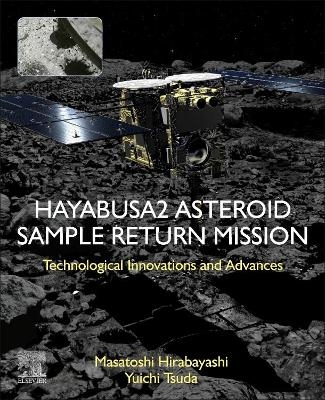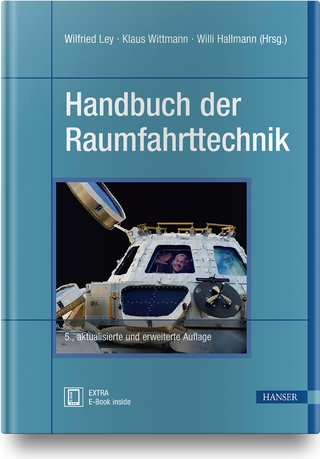
Hayabusa2 Asteroid Sample Return Mission
Elsevier - Health Sciences Division (Verlag)
978-0-323-99731-7 (ISBN)
Masatoshi Hirabayashi is an assistant professor in the Department of Aerospace Engineering at Auburn University in the United States. He graduated from the undergraduate school of Mechanical and Aerospace Engineering at Nagoya University in 2007 and obtained an M.S. degree in Aerospace Engineering at the University of Tokyo in 2010. After moving to the U.S., he received an M.S. degree in 2012 and a Ph.D. degree in 2014 from Aerospace Engineering at the University of Colorado Boulder. After establishing a scientific research experience in the Planetary Sciences group at Purdue University, he joined Auburn in 2017. Over his career, he has been involved in international space exploration missions. During participating in the graduate school at the University of Tokyo, he was involved in system engineering development as an engineering team member of IKAROS led by JAXA, the first Japanese Solar Sail mission, to contribute to its success at ISAS/JAXA in Sagamihara, Japan. Currently, he is a Co-I of the Optical Navigation Camera team in the Hayabusa2 mission and has played a critical role in science investigations and international communications. He is also a member of the investigation team of NASA/DART. Furthermore, he is serving as a Co-I of the BepiColombo mission led by ESA/JAXA and a collaborator of the OSIRIS-REx mission led by NASA. Through these small-body mission experiences, he has accumulated experience in space mission design, development, and operations, as well as scientific investigations. The experience in these missions allows him to lead the development of this book.
1. Introduction Tsuda, M. Yoshikawa, Hirabayashi, Kikuchi Summary of this book
2. Mission objectives Tsuda, M. Yoshikawa
3. Cruise and approach phases Tsuda, Saiki
4. Asteroid-proximity phase Tsuda, Saiki
5. Re-entry phase Tsuda, Saiki, Nakazawa Including the collection of the sample capsule
6. Operation planning and execution 6 Station-keeping (HPNAV) Takei, Keep the spacecraft at the home position.
7. Controlled descent (GCP-NAV) Ono, Ogawa Descent for special operations. Ground Control Point Navigation
8. Observation campaign Takei, Operations for Box-A, B, C, Mid-alt, DO, CRA1, 2.
9. TD (6DoF control) Terui Touchdown planning and results
10. TMT Ogawa Image processing
11. MASCOT Mimasu Separation of MASCOT, and interface between JAXA and DLR/CNES
12. MINERVA-II-1, 2 K. Yoshikawa, van Wal. MINERVA-II-1 separation operation and landing site operation
13. SCI Saiki, Mimasu
14. Solar conjunction phase Soldini
15. Fault management Takei,
16. Spacecraft dynamics, orbit determination, and trajectory design 16 Gravity/Radiometric science Ikeda, Takeuchi Gravity measurement
17. IES trajectory design Tsuda Low-thrust trajectory design and approach trajectory design
18. Orbit determination Takeuchi Orbit determination during Regular and Special Operation; Optical Navigation Phase, DDOR.
19. Contact dynamics K. Yoshikawa Spacecraft dynamics during the touchdown operation, especially during the contact.
20. MINERVA/TM orbit design Ooki, K. Yoshikawa, Ikeda Orbit design for MINERVA-II-2, and its dynamics
21. Quasi-periodic orbit Kikuchi Searching for orbits that the spacecraft can stay around the body.
Hardware systems developments
22. Sampler Sawada, K. Yoshikawa
23. IES Nishiyama, Hosoda, Tsukizaki Ion Engine System
24. Power system Shimada
25. Thermal design Nakazawa Thermal design and analysis; thermal analysis for the touchdown operation
26. AOCS AOCS
27. Communication subsystem Toda, Takei
28. RCS Mori
29. LIDAR, LRF Terui
30. CAM-H, DCAM Sawada
31. Sample-return capsule Yamada, Nakazawa Return capsule design
32. Ground station Fujii, Takeuchi Communication operation using the Usuda station and DSN.
33. HIL (operation training) Takei Operation training
34. Data archive (SPICE) Yamamoto Hayabusa2 mission and beyond
35. Outreach activity M. Yoshikawa
36. Industrial effort NEC
37. Extended mission Mimasu, Hirabayashi, at al Extended mission of the Hayabusa2 mission
| Erscheinungsdatum | 22.04.2022 |
|---|---|
| Zusatzinfo | 200 illustrations (200 in full color); Illustrations |
| Verlagsort | Philadelphia |
| Sprache | englisch |
| Maße | 191 x 235 mm |
| Gewicht | 1220 g |
| Themenwelt | Technik ► Luft- / Raumfahrttechnik |
| ISBN-10 | 0-323-99731-7 / 0323997317 |
| ISBN-13 | 978-0-323-99731-7 / 9780323997317 |
| Zustand | Neuware |
| Haben Sie eine Frage zum Produkt? |
aus dem Bereich


